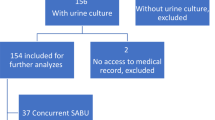Abstract
The purpose of our study was to examine the extent of anaerobic bacteriuria in catheterized patients in the intensive care unit (ICU) and to search for risk factors for anaerobic bacteriuria. A urine culture was collected from each patient every 2 days during their ICU stay and incubated under aerobic and anaerobic conditions. Aerobic and anaerobic blood cultures were collected as well. Demographic, clinical, and laboratory data were collected from patient files. Ninety patients were included in this study, 32 women (35.6%) and 58 men (64.4%). A total of 663 cultures were obtained. Twenty-three patients (25.6%) had growth of anaerobic bacteria in a urinary culture at some point during ICU stay, with Bifidobacterium being the most common pathogen. Aerobic urinary cultures were positive in 38 patients (42.2%). A significant statistical correlation was found between the presence of aerobic and anaerobic bacteria in urine culture (p = 0.0004). Treatment with glycopeptides was found to be inversely associated with anaerobic bacteriuria (p = 0.0292), and treatment with imidazoles was associated with an increased risk of anaerobic bacteriuria (p = 0.0186). None of the patients developed bacteremia with the same anaerobic pathogen that was isolated from their urine. Anaerobic bacteriuria is a common phenomenon in catheterized patients in the ICU. Further studies are needed in order to define the clinical significance of these findings in such patients and in other patient groups as well as in healthy people.

Similar content being viewed by others
References
Kogan IM, Naboka YL, Ibishev KS, Gudima IA, Naber KG (2015) Human urine is not sterile - shift of paradigm. Urologia 94(4):445–452
Vuotto C, Donelli G (2015) Anaerobes in biofilm-based healthcare-associated infections. In: Donelli G (ed) Biofilm-based healthcare-associated infections. Springer International Publishing, Cham, pp 97–112
Brook I (2004) Urinary tract and genito-urinary suppurative infections due to anaerobic bacteria. Int J Urol 11(3):133–141
Imirzalioglu C, Hain T, Chakraborty T, Domann E (2008) Hidden pathogens uncovered: metagenomic analysis of urinary tract infections. Andrologia 40:66–71
Nicolle LE (2014) Catheter associated urinary tract infections. Crit Care 1:4
Leone M, Albanèse J, Garnier F, Sapin C, Barrau K, Bimar MC, Martin C (2003) Risk factors of nosocomial catheter-associated urinary tract infection in a polyvalent intensive care unit. Intensive Care Med 29(7):1077–1080
Laupland KB, Zygun DA, Davies HD, Church DL, Louie TJ, Doig CJ (2002) Incidence and risk factors for acquiring nosocomial urinary tract infection in the critically ill. J Crit Care 17(1):50–57
Ashraf F, Iram SS, Rasheed F, Shaukat M (2015) Comparison between non-catheterized and catheter associated urinary tract infections caused by extended spectrum Β-lactamase producing Escherichia coli and Klebsiella pneumonia bioRxiv:019026
Nicolle LE (2005) Catheter-related urinary tract infection. Drugs Aging 22(8):627–639
Khasriya R, Sathiananthamoorthy S, Ismail S, Kelsey M, Wilson M, Rohn JL, Malone-Lee J (2013) Spectrum of bacterial colonization associated with urothelial cells from patients with chronic lower urinary tract symptoms. J Clin Microbiol 17(4):2054–2062
Smelov V, Naber K, Bjerklund Johansen TE (2016) Letter to the editor: diagnostic criteria in urological diseases do not always match with findings by extended culture techniques and metagenomic sequencing of 16S rDNA. Open Micro J 10:23–26
Chenoweth C, Saint S (2013) Preventing catheter- associated urinary tract infections in intensive care unit. Crit Care Clin 29(1):19–32
Kodner CM, Thomas Gupton EK (2010) Recurrent urinary tract infections in women: diagnosis and management. Am Fam Physician 82(6):638–643
Headington JT, Beyerlein B (1966) Anaerobic bacteria in routine urine culture. J Clin Pathol 19(6):573–576
Padawer D, Pastukh N, Nitzan O, Labay K, Aharon I, Brodsky D, Glyatman T, Peretz A (2015) Catheter-associated candiduria: risk factors, medical interventions, and antifungal susceptibility. Am J Infect Control 43(7):e19–e22
Al-Hameed FM, Ahmed GR, AlSaedi AA, Bhutta MJ, Al-Hameed FF, AlShamrani MM (2018) Applying preventive measures leading to significant reduction of catheter associated urinary tract infections in adult intensive care unit. Saudi Med J 39(1):97–102
Garibaldi RA, Burke JP, Dickman ML, Smith CB (1974) Factors predisposing to bacteriuria during indwelling urethral catheterization. N Engl J Med 291:215–230
Naboka I, Gudima IA, Kogan MI, Ibishev KS, Chernitskaia ML (2013) The microbial spectrum of urine and bladder bioptic samples in women with chronic recurrent cystitis. Urologiia 4:16–18 [Russian]
Lewis DA, Brown R, Williams J, White P, Jacobson SK, Marchesi J, Drake MJ (2013) The human urinary microbiome; bacterial DNA in voided urine of asymptomatic adults. Front Cell Infect Microbiol 15(08):41
Siddiqui H, Nederbragt AJ, Lagesen K, Jeansson SL, Jakobsen KS (2011) Assessing diversity of the female urine microbiota by high throughput sequencing of 16S rDNA amplicons. BMC Microbiol 11:244
Bannon J, Hatem MH, Noone M (1998) Anaerobic infections of the urinary tract: are they being missed? J Clin Pathol 51:709–710
Brubaker L, Wolfe AJ (2017) The female urinary microbiota/microbiome: clinical and research implications. Rambam Maimonides Med J 8(2):e0015
Foxman B (2014) Urinary tract infection syndromes occurrence, recurrence, bacteriology, risk factors, and disease burden. In Dis Clin Nam 28:1–13
Finegold SM (1996) Anaerobic gram negative bacilli. In: Baron S (ed) Medical microbiology, 4th. University of Texas Medical Branch at Galveston chapter 20
Brook I, Long SS (2012) Principles and practice of pediatric infectious disease. Science Direct 958-966:e3
Dubreuil L, Odou MF (2010) Anaerobic bacteria and antibiotics: what kind of unexpected resistance could I find in my laboratory tomorrow? Anaerobe 16(6):555–559
Author information
Authors and Affiliations
Corresponding author
Ethics declarations
Conflict of interest
The authors declare that they have no conflict of interest.
Ethical approval
The study was approved by the Poriya Baruch Padeh Medical. Committee approval no. is 0020-15-POR.Center Helsinki Committee.
Informed consent
Informed consent was obtained from all study participants.
Rights and permissions
About this article
Cite this article
Rozenfeld, K.L., Nitzan, O. & Peretz, A. Presence of anaerobic bacteria in the urinary tract of catheterized ICU patients. Eur J Clin Microbiol Infect Dis 37, 2131–2136 (2018). https://doi.org/10.1007/s10096-018-3349-9
Received:
Accepted:
Published:
Issue Date:
DOI: https://doi.org/10.1007/s10096-018-3349-9




